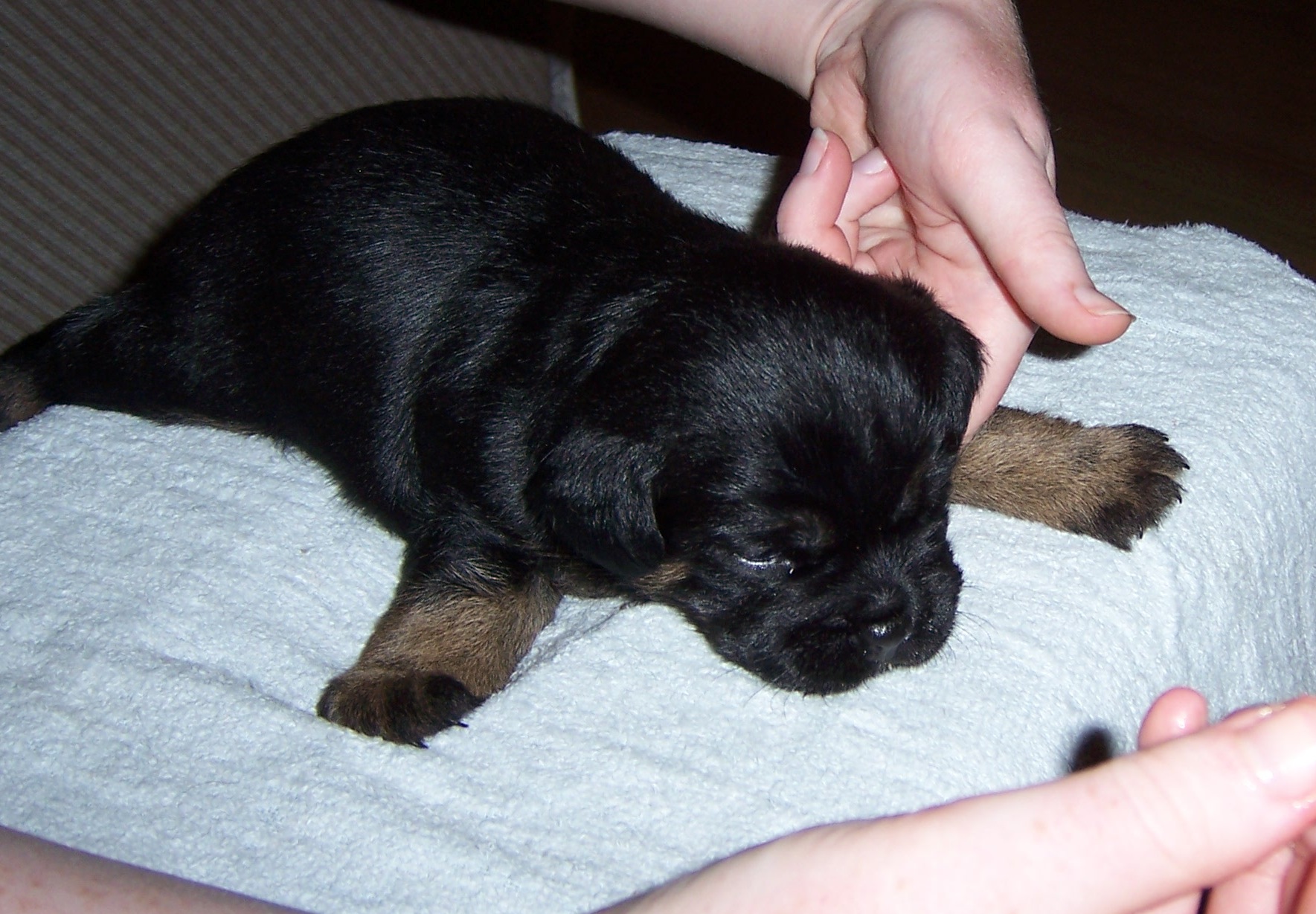How to Save a Swimmer Puppy
THERE IS HOPE FOR SWIMMER PUPPIES. THEY DO NOT NEED TO BE EUTHANISED.
Phew. Okay, I just wanted to get that off my chest. For anyone who is googling for help for their swimmer puppy, the search results can be very dis-inspiring. I wanted to explain that it actually only takes a few days to a week to get a swimmer puppy to a mostly normal pup, and then several more weeks until the puppy is unrecognisable as a past swimmer.
What is a swimmer puppy?
A swimmer puppy is a very young puppy, normally 4 weeks of age or younger, who has legs that stick out to the side rather than underneath. Their chest is normally flat, and their back legs sometimes drag behind them. This often means that swimmer puppies struggle to walk, as their legs don’t push them off the ground, merely along it (‘swimming’ along the ground). It is important that a swimmer’s puppies legs are righted as soon as possible.

This is the swimmer puppy we had in our 2010 litter, pictured at 3 weeks. He was born with some signs of being a swimmer. You can see that his legs stick out to the side instead of underneath or in front of him. Unfortunately, his condition was not recognised until a week later – but he still was walking normally by 8 weeks, and is not recognisable as a swimmer today.
What causes swimmer puppies?
Some puppies are undeniably born as ‘swimmers’, with legs that stick out to the side. However, whether this is genetic (caused by genes) or merely congenital (caused by in-utero-carriage) is hard to say. Many people report that puppies sometimes develop symptoms after being held in particular ways, as their bones are soft and pliable. From this logic, it’s not unfathomable that difficult birthing could also result in puppies that may be ‘pressed’ into a swimmer body shape.
However, a lot of swimmers are born as normal puppies and then become swimmers through their environment. One of the most significant causes of swimming is when litters are raised on surfaces with poor traction – particularly surfaces like newspaper. These puppies can’t gain purchase on the floor, and end up ‘swimming’ instead of moving. As noted above, some claim that puppies can become swimmers through routine poor handling (e.g. applying pressure to the pup’s chest when holding) and even one-off unfortunate incidents (e.g. a bitch laying on a pup). Puppies in small litters (especially singleton puppies) are at risk of becoming swimmers from being overweight.
How do I fix a swimmer puppy?
They can be fixed! The sooner you begin to implement some of these fixes, listed below, the faster you will begin to see improvements. (And the longer you leave it, the worse the condition can be.)
- Make sure the bedding in your whelping box is easy for the puppy to grip on! Vet bed is great for this, but you can also use carpet, rubber matting, synthetic grass, etc.
- Make the surface of the whelping box undulating. You can achieve this by putting egg carton, lumpy foam, or scrunched up newspaper underneath the bedding in the whelping box. This helps to encourage swimmer puppies to use their hind legs.
- Place the puppy in sleeping positions that are helpful to recovery. Puppies that sleep on their chest will exacerbate the flatness on their chest, so place sleeping swimmer puppies onto their side at every opportunities. Also ‘tuck’ in the legs of these puppies, so they’re underneath the pup’s body and not out to the side. Obviously you can’t do this all the time, but even doing this occasionally will see improvements.
- Be conscious of the way you hold the swimmer puppy. Don’t hold the puppy in a way that exacerbates the symptoms – so don’t place pressure on their chest, and don’t encourage the legs to stick out sidewards.
- You can hobble the puppy. Basically, create ‘paw cuffs’ that pull the legs together using tape, a small child’s sock, or whatever may work. Obviously, make sure that the cuffs don’t cut off circulation. Even though this feels barbaric to do, the puppies I have done this to have not really objected to the process. (Click for photos of the puppy handcuff method.)
- Let the puppy have sleeps in a sling (like an inside out pillow case hanging on a chair) in between feeds. (Ensure puppy is kept at an appropriate temperature.) Make sure the puppy’s legs are in the appropriate position before you leave them hanging – you don’t want to exacerbate their swimmer status! (Click for photos of the puppy sling method.)
- Apply puppy-physio. Put puppy on your lap on their back, and gently massage their legs and ribs, and move legs in all directions – gently!
- Encourage the swimmer puppy to move around, even by simply making them ‘walk to the milkbar’.
- For obese swimmer puppies, restrict feeding times and especially get them to ‘walk to the milkbar’ (work off their meals!)
- Some anecdotal evidence suggests that an overheated whelping box could aggravate the condition. Depending on your particular context, it may want to reconsider any external heating in the whelping box.

The same puppy at 9 months. This puppy had pretty much all the methods outlined applied from 4 weeks old, and was walking normally by 8 weeks.
How do I prevent swimmer puppies?
Recognise the symptoms and act immediately! All the advice suggested above won’t hurt a puppy that is ‘normal’. Indeed, it’s just good sense to have a whelping box with good traction and try to manage the weight of young puppies. Starting early in swimmer rehab will see earlier results, and get the puppy normal sooner rather than later.
As there may be a genetic basis to swimmer puppies, seriously consider running on swimmer puppies for breeding purposes. This is particular true if you are consistently getting swimmer puppies in your litters, despite implementing high-traction surfaces and otherwise ‘doing everything right’ in terms of managing your whelping box environment.
Please share your successes with swimmer puppies. I would love to hear from you.
For more information, see the post Photographic Guide to Saving Swimmer Puppies.
This post is created with thanks to the Swimmer Pups thread on Dogz Online, and all the breeders who have contributed.




